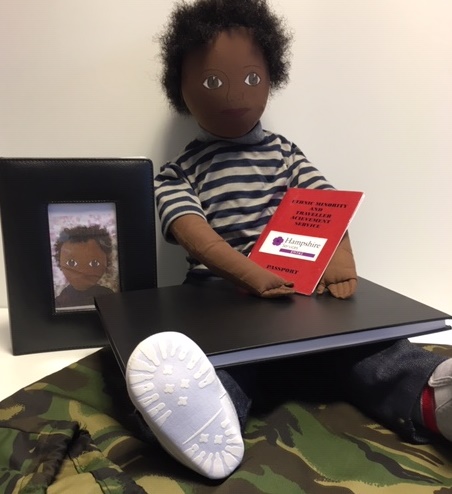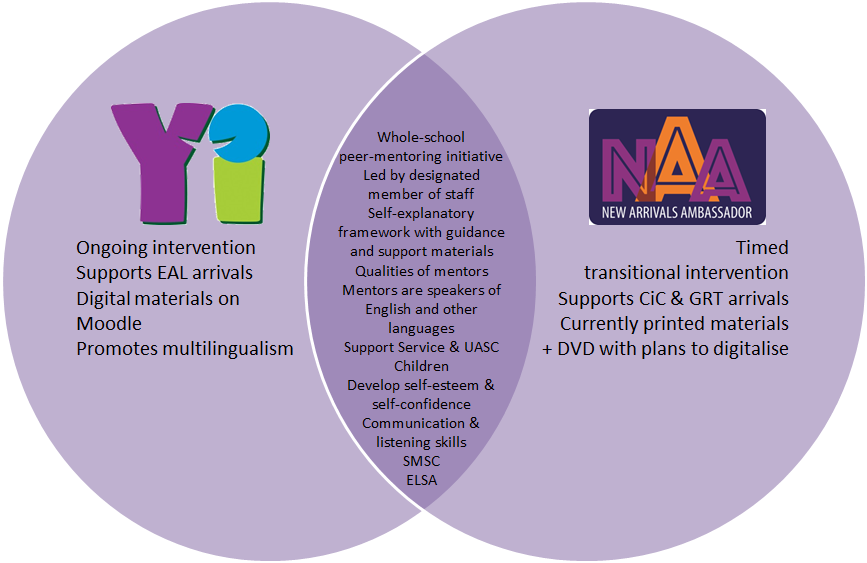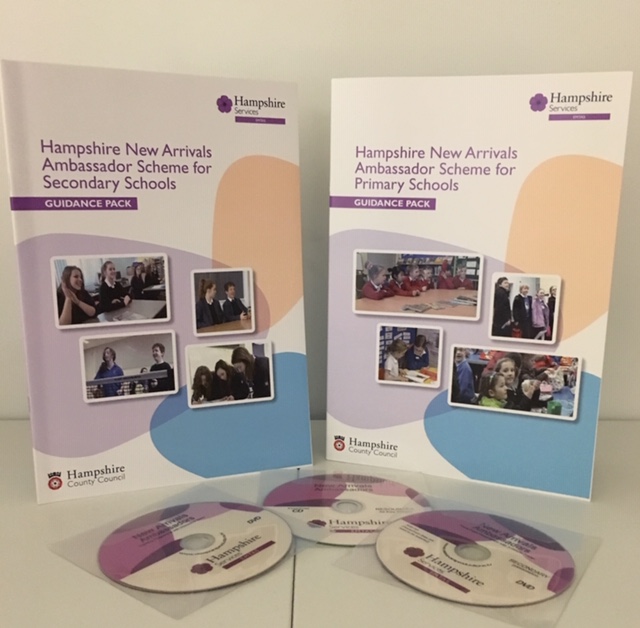Site blog
In a previous blog, Hampshire EMTAS colleagues Smita Neupane and Sudhir Lama discussed the use of persona dolls in a project aiming to support transition in Early Years and Key Stage 1 with a particular focus on Service children. In this blog, Cherrywood Community Primary School’s EAL Co-ordinator Dawn Tagima shares one year group’s experience of working with Himal.

Year 1 children at Cherrywood Community Primary School in Farnborough were delighted to welcome a brand new member to their class, Himal who was from Nepal. Cherrywood Community Primary School has a high number of children with EAL however not many are from a Service background. The school does have experience of working with the local Nepali community and the Year 1 classroom teacher leading this project is herself Nepali. So when the school looked for creative ways to support transition, the persona doll project (and specifically Himal) fitted the bill.
Himal came with his own passport and a 'talking book' which told the children all about his country. The children were told about the fact that Himal was new to this country and how he must be feeling. This encouraged conversations from our children about their own experiences and their own family situations.
Himal was given his own special place to sit in the classroom and the children involved him in every aspect of the school day. They particularly loved sitting and reading to him!
The children made a book about their plans for Himal both in school and at home. Himal was lucky to go home with many of the children to take part in family celebrations and trips out. The children shared this with the class, brought in photos and wrote about it in Himal’s scrapbook.
Himal helped to introduce a brand new topic about feelings and this encouraged the children to produce some amazing work.

Himal has now gone off to another school much to the disappointment of our children but they are always reminded of him with a lovely display in our main hallway and we hope he can come and visit us again when he returns from his 'travels'.
The children gained so much from Himal’s visit. We talked about religious traditions, diversity, beliefs, equality, inclusion, self-esteem, ideas, opinions, sensitivity and pride.
I encourage Early Years and KS1 settings to consider using persona dolls with the children. Simply contact Hampshire EMTAS to discuss the loan of dolls and resources.
by Smita Neupane and Sudhir Lama, Nepali Bilingual Assistants with Hampshire Ethnic Minority and Traveller Achievement Service

Have you ever used a Persona doll? Do you know how and why to use a Persona Doll? Persona Dolls are an ELSA resource and emotional literacy support tool used to initiate talk and to share experiences within the classroom. EMTAS were awarded an amount of money in an MOD bid to work with Infant and Early Years settings to introduce Personal Dolls to help all children cope with the demands of moving school, house, and even country with a particular focus on Service children. The Persona Doll project is also designed to involve the family and community and to share experiences with peers. It has an intergenerational element with the involvement of secondary pupils supporting the creation of some of the resources.
In the beginning…
Hampshire is an area rich with Service children across the length and breadth of the county and spanning all the educational phases. The project is designed to support Early Years children but to make it relevant, the experiences of older children was needed and had to be included in the package.
Initially, before the Persona Dolls had joined us, the work started at The Wavell School, with two Nepali Bilingual Assistants from Hampshire Ethnic Minority and Traveller Achievement Service (EMTAS) interviewing students with backgrounds from Fiji, Nepal, Malawi and Jamaica. They shared their stories and were open and honest about their experiences including the difficulties faced during transition and the worries about having a parent in the forces. They spoke of homesickness and missing friends and family, the foods they missed and aspects of their lives that had changed. Some of the students were UK born so had not lived in their parents’ country of origin so they took time to find out as much about their culture and history as they could through their families and community. The students created talking books from this information that included pictures and speech both in English and first language. Some of the books included nursery rhymes from their culture and how to count in their first language. The books are proactive and help bring the Persona Dolls alive. The Wavell children chose the dolls and named them ready for their journey into their schools.
First steps…
When the Talking books were all prepared and each Persona Doll had its name and a passport produced, they were packed up ready to travel with their big note book to record their experiences. The dolls have been taken to infant and primary schools all over the county and the idea is that they stay in that school for roughly half a term and then they are off on their travels again. The doll is taken into the school and introduced into the class where it will be staying and the children get to ask it questions and to find out what it likes and dislikes.
Some ground rules were set:
- doesn’t matter how dirty the doll gets
- no face painting, hands or feet painting of the doll!
- it is not to be used as a reward
- it has to be included on the register
- it has to have its own seat, peg etc.
- it has to have lots of different experiences
- everything has to be recorded in the Persona Doll’s book and shared.
The first doll to leave EMTAS was Himal, a Nepali boy, and he went off to Talavera Infant school and Becky the class teacher. Becky and the class totally embraced this project and the work was amazing. Himal attended an Eid festival where he was gifted new shoes. He went to a Christening. He went to a hot tub party (but just watched). He also shared his feelings about moving to a new school and how this made him feel.
The Persona Dolls generate lots of discussion with the children. It encourages them to think about how they feel when they experience trying something for the first time. It makes them think about what a good friend is and how a good friend can support a new arrival. It allows the children to talk about things that may worry them about transition and about what is happening in their lives at home and at school.
Desired outcomes …
It is hoped that the eight dolls will continue to transition from setting to setting and may even revisit schools they have been to already as can happen with Service children.
One of the aims of the project was to help build up pupil self esteem and confidence. It is hoped that through exposure to the stories children will want to talk and share their own feelings and experiences. Through listening to each other’s experiences it helps children realise that they are not alone in what they are feeling and it is okay to feel that way.
While the project has a fun element of taking the doll to different celebrations and events it is also teaching social and emotional skills through communication and responsibility.
The feedback so far from two schools has been very positive and the children have loved having their guest to stay and were really sad when they left. This too helped teach pupils resilience as many children feel unhappy and lost when their best friend moves on and this helps them build up coping strategies to deal with this and invites discussion within the classroom to look at feelings.
Do you want to be part of this?
If you are a Hampshire school and would like to be part of this ongoing project please email Claire Barker, claire.barker@hants.gov.uk. We would be delighted to have you come on board and training is available this term.
Please see our website for further information on the use of Persona Dolls.
If you are a school outside Hampshire and would like a chat about how to set this up in your area, please contact Claire Barker, claire.barker@hants.gov.uk.
Several articles about the Young Interpreter (YI) Scheme and New Arrivals Ambassador (NAA) Scheme have already featured in the Hampshire EMTAS blog and many schools in Hampshire and across the UK are running either peer mentoring scheme - sometimes both - to support their new arrivals. Other schools have questions. Which scheme should we go for? Do they overlap? What difference is there? Our scheme managers Astrid Dinneen (YI) and Claire Barker (NAA) shed some light.

© Copyright Hampshire EMTAS 2019
Q: How did the schemes come about? Why did EMTAS decide to develop two separate schemes?
Astrid Dinneen: Back in 2004 we saw an increase of new EAL arrivals in schools after the accession of several countries to the EU. To support the well-being of these children, Hampshire EMTAS worked with school-based practitioners in four Hampshire schools to develop the Young Interpreter Scheme. The aim was to create a special role and train children/young people to become buddies and help new-to-English arrivals to feel welcome and settled. We are very proud to have won several awards since piloting the YI Scheme. Can you believe that the scheme is running in over 900 schools now?
Claire Barker: The New Arrivals Ambassador Scheme was borne out of a need by Children in Care, Traveller Children and Service Children to gain extra support when they arrived in schools at irregular times of the school year. Like the Young Interpreter Scheme, the aim was to support the well-being of these groups of children and to ensure they had a smooth transition into their new setting. The idea was to provide a short, sharp, peer mentoring programme lasting about half a term or in line with the needs of the newly arrived child. The scheme evolved after a successful piloting period that involved six schools covering all three phases.
Q: So each scheme is designed to support different groups of children, is it?
Astrid Dinneen: Yes. If your aim is to support EAL pupils whilst promoting the linguistic diversity of your school community then you may like to consider the Young Interpreter Scheme.
Claire Barker: And if your aim is to support all children joining your school at irregular times of the school year, including Children in Care, Traveller children and Service children, then you may like to consider the New Arrivals Ambassadors Scheme.
Astrid Dinneen: Of course some Service children and Children in Care (and particularly Unaccompanied Asylum Seeking Children) will also have English as an Additional Language so it's worth considering your school's needs carefully. Some schools are successfully running both schemes.
Q: How would running both schemes look?
Astrid Dinneen: An important feature of the YI and NAA schemes is that each is delivered by a designated member of school staff. In schools where both schemes are running it’s a good idea for each to be led by different people who can cater for their own scheme’s specificities and also collaborate on joint work. For example, the Young Interpreter Co-ordinator will buddy up Young Interpreters with new EAL arrivals. When a new EAL arrival also happens to be a Service child, then Young Interpreters can work alongside New Arrival Ambassadors to show them the ropes.
Another important aspect of running the Young Interpreter Scheme is that the Co-ordinator regularly meets with the Young Interpreters to guide them and keep them motivated in their role. This follow up phase could be another opportunity for joint work and there are suggested activities on the YI’s Moodle. For example, why not work together to promote both NAA and YI roles by creating a movie trailer?
In terms of pupil selection I think the qualities you would look for in Young Interpreters are similar to those you would expect from a New Arrival Ambassador. Pupils should be friendly, empathetic, welcoming and good communicators. Young Interpreters can be speakers of English only and they can be speakers of other languages too. The same could be said of the NAA, couldn’t it?
Claire Barker: It certainly could and the schemes complement each other when both are running in the same school setting. It is worth remembering that the NAA Scheme is a timed transitional intervention whereas the YI Scheme is ongoing with its support. The aim of the NAA is to develop the self-esteem and self-confidence of the newly arrived child so they are able to function independently after half a term.
I agree with Astrid that the two schemes work better when managed by different people in the school so the lines of what each scheme has to offer do not become blurred. Whilst the skills and qualities of a Young Interpreter and an Ambassador are virtually the same, the job description is very different and each has its own demands and specialist areas for the trained pupils. NAA pupils have to learn to build relationships and trust quickly as their support is delivered over a short period of time. Schools do utilise the trained Ambassadors in different ways throughout the year. Some schools use the Ambassadors to support the new intake in September and to work with classes and tutor groups throughout the academic year. Many schools use the Ambassadors alongside their School Council to represent the school on Open events like Parents’ Evenings. Some schools use their Ambassadors to support existing pupils who are struggling with their well-being and life at school. The scheme has flexibility to be adapted to the setting it is being used in.
Both schemes complement each other and pupils who are Young Interpreters and Ambassadors are highly skilled and proficient peer mentors who can offer linguistic support, well-being support and transition support. Both schemes develop self-esteem and confidence in the Young Interpreters and Ambassadors as well as in the pupils they are supporting and provide opportunities for personal growth.
Q: Where can our readers find out more?
Astrid Dinneen: You can learn more about the Young Interpreters on our website, follow us on Twitter or Facebook or read the December issue of the Young Interpreters Newsletter.
Claire Barker: There is information about the NAA on our website. You can also use the tabs below to read other blogs relating to both schemes.
By Laura Harman-Box, Year 6 teacher with responsibility for the New Arrival Ambassadors (NAA) at Talavera Junior School with an introduction from EMTAS Specialist Teacher Advisor Claire Barker.

Recently I had the pleasure of working in Talavera Junior School in Aldershot. I went to train thirteen young people to be New Arrival Ambassadors (NAA). Talavera Junior School is a very diverse school that welcomes children from many counties, cultures and religions. Many of their children are from Service families and this is one of the groups than New Arrivals Ambassadors works particularly well with. Many Service children are used to transition in their lives and are able to talk confidently about what makes a good transition for them. The children who have experienced transition all say how they wished they had had a New Arrivals Ambassador when they went to their new school. It highlights to the whole cohort that is being trained that everyone - adults and children - experience the same fears and insecurities when faced with a new challenge and setting. Laura Harman-Box, Year 6 teacher at Talavera with responsibility for NAA had this to say after the training:
The New Arrival Ambassador Scheme seemed like a perfect fit for our school, working both as a welcoming system for our high level of new entrants and as a chance to develop leadership qualities in our pupils.
As a school in a garrison town, our school population can be very turbulent. This is, understandably, difficult for some pupils, particularly when they find it hard to then find their place in their new environment. We believe that we offer great support for pupils who enter at an unusual time of the year but are also aware that some pupils will need additional transitional support. Who better to deliver this than the peers with whom our new arrivals will be learning, playing and growing?
We chose our New Arrival Ambassadors based on the emotional literacy level of the children and children who would themselves benefit from taking on a role of responsibility within our school. The training itself was such a positive experience, in part because of the diverse range of children (ethnically, culturally, age-wise, academically, with regards to interests) who could bring an eye-opening number of experiences to this scheme. Encouraging and providing opportunities for all pupils is a fundamental value of our school, especially leadership roles. The NAA Scheme has provided us the chance to give this opportunity to children who may not otherwise always get it.
Our pupils' well-being is a continued focus for us and the
NAA scheme provides another valuable way of ensuring all pupils feel safe,
comfortable and ready to learn. This is the start of a journey for our New
Arrivals Ambassadors, one that they cannot wait to begin! Here are their comments:
Today we learnt about becoming a New Arrival Ambassador and how we can help new arrivals with settling in their new class without making them panic. We learnt today that new arrivals can choose who they want to be friends with, which surprised some of us. We thought it would be our job to be their friend but our trainer, Claire, helped us to understand that everyone should choose their own friends. We were taught that if a new arrival tells us something and it is serious, we must tell the teacher immediately due to the fact that we can't always help them. We've learnt that a New Arrival Ambassador is a very important job and we must work hard to continue to represent our school and make every new pupil feel comfortable and safe here. We look forward to being New Arrival Ambassadors!
Visit the Hampshire EMTAS website to find out more about the NAA and come back soon to read a blog comparing the NAA with the Young Interpreter Scheme.
